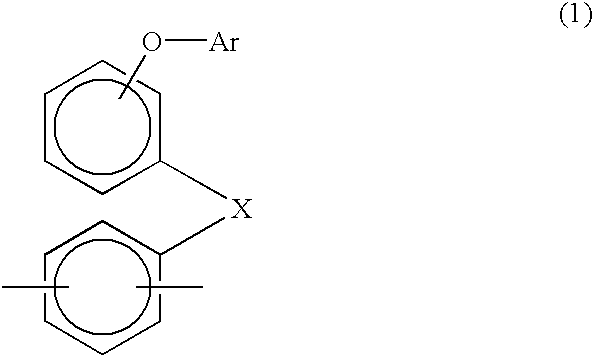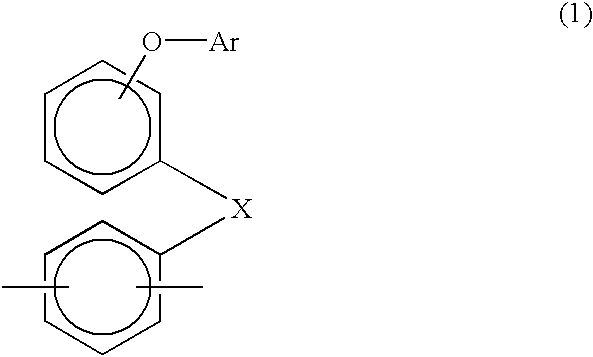Polymer electrolyte membrane, method for producing same, and membrane electrode assembly and polymer electrolyte fuel cell comprising same
a technology of polymer electrolyte and membrane electrodes, which is applied in the direction of non-aqueous electrolyte cells, cell components, sustainable manufacturing/processing, etc., can solve the problems of high cost, insufficient nafion.rtm., and mounting demand, and achieve the effect of low ion conductivity dependen
- Summary
- Abstract
- Description
- Claims
- Application Information
AI Technical Summary
Benefits of technology
Problems solved by technology
Method used
Image
Examples
example 2
[0094] A polymer electrolyte fuel cell was produced in the same manner as in EXAMPLE 1 except for preparing a polymer electrolyte membrane using an ion-conducting, aromatic polymer membrane made of a sulfonated polyarylene represented by the following chemical formula (5): 7
[0095] and having a weight-average molecular weight of 60,000 and an ion exchange capacity of 1.7 meq / g.
[0096] This ion-conducting, aromatic polymer membrane had an initial water content of 94 weight % based on the aromatic polymer. The ion conductivity of this polymer electrolyte membrane was measured before and after the hot-water treatment. The initial water content of the polymer electrolyte membrane, their B / A ratios before and after the hot-water treatment, and their D / C ratios are shown in Table 1.
example 3
[0097] An polymer electrolyte fuel cell was produced in the same manner as in EXAMPLE 1 except for preparing a polymer electrolyte membrane using an ion-conducting, aromatic polymer membrane made of a sulfonated polyarylene represented by the chemical formula (4) and having an ion exchange capacity of 2.5 meq / g.
[0098] This ion-conducting, aromatic polymer membrane had an initial water content of 276 weight % based on the sulfonated polyarylene. The ion conductivity of this polymer electrolyte membrane was measured before and after the hot-water treatment. The initial water content of the polymer electrolyte membrane, their B / A ratios before and after the hot-water treatment, and their D / C ratios are shown in Table 1.
example 4
[0099] An polymer electrolyte fuel cell was produced in the same manner as in EXAMPLE 1 except for preparing a polymer electrolyte membrane using an ion-conducting, aromatic polymer membrane made of sulfonated polyarylene represented by the following chemical formula (6): 8
[0100] and having an ion exchange capacity of 1.5 meq / g.
[0101] This ion-conducting, aromatic polymer membrane made of sulfonated polyetheretherketone had an initial water content of 300 weight % based on sulfonated polyetheretherketone. The ion conductivity of this polymer electrolyte membrane was measured before and after the hot-water treatment. The initial water content of the polymer electrolyte membrane, their B / A ratios before and after the hot-water treatment, and their D / C ratios are shown in Table 1.
1TABLE 1 Initial Water B / A Before B / A After Content Hot-Water Hot-Water No. (weight %) Treatment Treatment D / C EXAMPLE 1 114 20.58 8.17 0.40 EXAMPLE 2 94 30.25 10.0 0.33 EXAMPLE 3 276 11.03 5.0 0.45 EXAMPLE 4 ...
PUM
| Property | Measurement | Unit |
|---|---|---|
| mol % | aaaaa | aaaaa |
| humidity | aaaaa | aaaaa |
| humidity | aaaaa | aaaaa |
Abstract
Description
Claims
Application Information
 Login to View More
Login to View More - R&D
- Intellectual Property
- Life Sciences
- Materials
- Tech Scout
- Unparalleled Data Quality
- Higher Quality Content
- 60% Fewer Hallucinations
Browse by: Latest US Patents, China's latest patents, Technical Efficacy Thesaurus, Application Domain, Technology Topic, Popular Technical Reports.
© 2025 PatSnap. All rights reserved.Legal|Privacy policy|Modern Slavery Act Transparency Statement|Sitemap|About US| Contact US: help@patsnap.com



